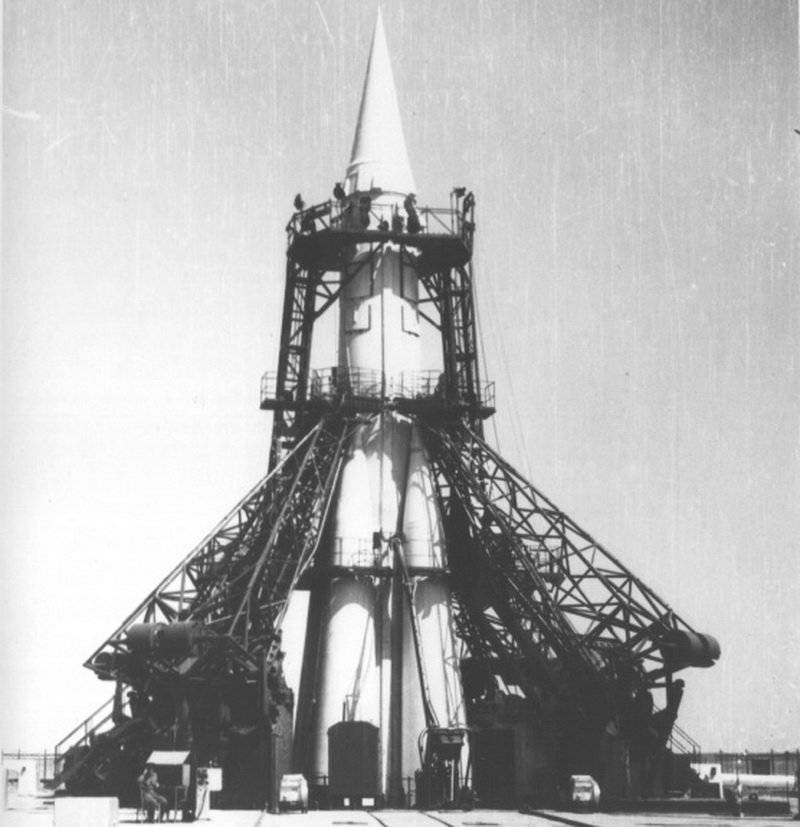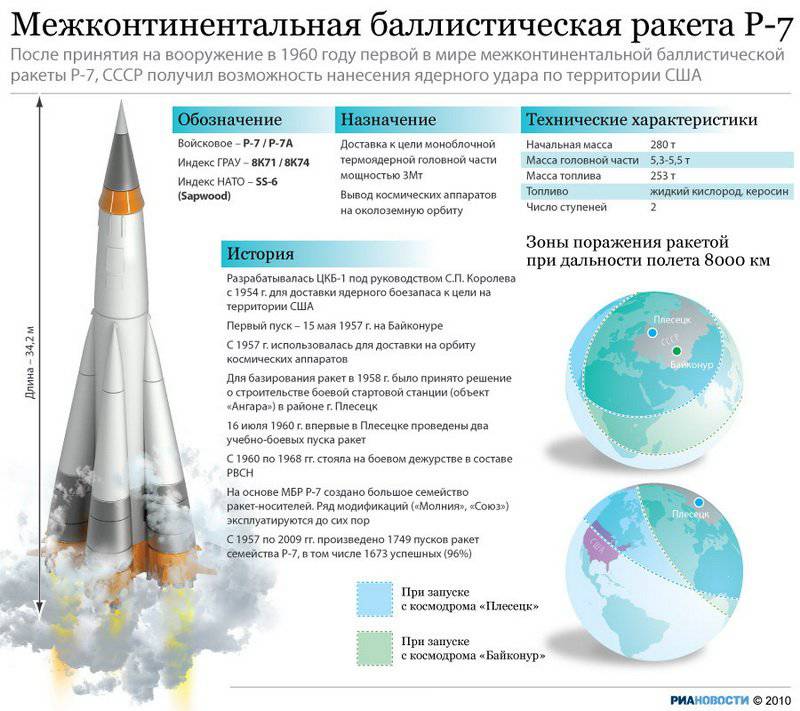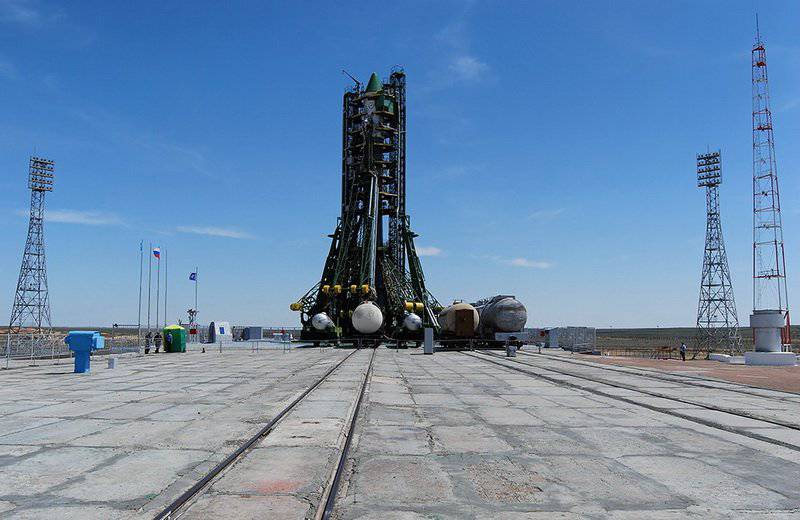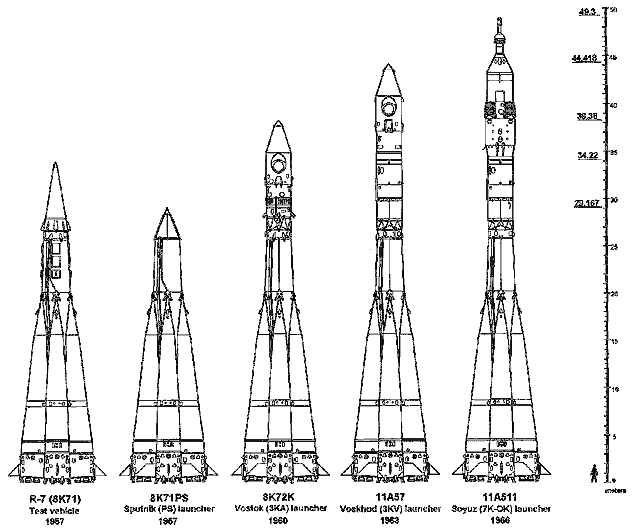The rocket R-7, which opened the way to space for a man, celebrates the 55 anniversary
The resolution on the creation of an intercontinental ballistic missile was signed by the Government of the USSR and the Central Committee of the CPSU 20 in May 1954. Work on the creation of the P-7 rocket, as well as all the necessary equipment required for its launches, was led by the legendary Sergei Korolev. Already at the beginning of 1957, the rocket was ready for testing. The design of the P-7 rocket was fundamentally different from all previously designed missiles with its power and layout schemes, weight and dimensions, the number and purpose of the systems, and the power of propulsion systems. In February, the Government of the USSR issued a decree on the commencement of work on the construction of an intercontinental ballistic missile testing ground. The Baikonur aul, located near the Tyura-Tam junction (Kazakhstan), was chosen as the place of construction. By April 1955, the launch complex for the new intercontinental P-1957 missiles was ready.
Since the middle of May, 1957, a series of tests of the new rocket was conducted at the cosmodrome. The first 3 launches were unsuccessful and revealed serious flaws in its design. During the subsequent analysis of telemetry data, it was possible to establish that at a certain moment of flight, when the fuel tanks were emptied, pressure fluctuations began to occur in the supply lines, which led to increased dynamic loads and, ultimately, to the destruction of the rocket design. It is worth noting that the Americans also faced these problems at that time. As a result, only the fourth launch of the rocket, which was carried out on 21 August 1957, was successful. Almost a week later, a TASS report was published in Soviet newspapers about successful tests of an ultra-long multistage rocket in the USSR.

The obtained positive results of the flight of the intercontinental ballistic missile P-7 in the active part of its trajectory allowed it to be used to launch the 2 of the first artificial satellites of the Earth 4 in October and 3 in November 1957. Created as modern weaponThis rocket had good energy capabilities, which allowed it to bring into the near-earth orbit a payload of a sufficiently large mass, which was more than used when launching satellites. The Soviet Army adopted this missile 20 January 1960. The rocket was in service with the army until the 1968 year.
The project to develop an intercontinental missile P-7 was one of the largest engineering programs that have ever been implemented in the USSR. The implementation of this project became the starting point for the development of many branches of science and technology that were related to rocket science. In the future, it was this successful project that became the basis for the creation of new basic modifications of rocket and space complexes, which include Sunrise, Vostok, Soyuz and Lightning.
The success and reliability of the P-7 design led to the possibility of its use as a launch vehicle. It was the carrier reactors of this family that opened up a new space age for humanity, with the help of this family of rockets:
- launch of the first artificial satellite into Earth orbit
- launch of the first satellite with a living being on board to Earth orbit
- launch of the first manned human apparatus into Earth orbit
- the conclusion of the station "Luna-9", which made the first stories soft landing on the lunar surface.

The design of the rocket R-7
The P-7 is a two-stage intercontinental ballistic missile equipped with a detachable head part with a mass of 3 tons and having a range of 8 000 km. Modification of this rocket under the designation P-7A with increased to 11 000 km. range was in service with the USSR Strategic Missile Forces from 1960 to 1968 year. In NATO, this missile received the code designation SS-6 (Sapwood), in the USSR, in turn, the GRAU index, 8 K74, was used. Subsequently, on the basis of the P-7 rocket, a huge number of middle-class launch vehicles were developed.
The P-7 rocket was developed by the OKB-1 team under the leadership of its chief designer S. P. Korolev and was produced according to the “package” scheme. The first stage of the intercontinental missile was the 4 side block, each of which had a length of 19 meters and the largest diameter of 3 meters. These blocks were symmetrically located around the central unit (the second stage of the rocket) and were connected to it with the help of the lower and upper belt of the power connections.
The design of all units was of the same type and included a support cone, a power ring, fuel tanks, a tail section, as well as a propulsion system. At each of the first-stage units of the rocket, liquid propellant rocket engines (LRE) RD-107, created in OKB-456, led by academician Glushko, were installed. These engines had a pumping fuel supply. The RD-107 engine was built in an open pattern and had 6 combustion chambers. Two of these cameras were used as helmsmen. This LRE developed thrust near the surface of the earth in 78 tons.
The central unit of the P-7 rocket included the instrument compartment, fuel and oxidizer tanks, the tail compartment, the power ring, the 4 steering gear and the cruise engine. At the second stage of the rocket, an LRE RD-108 was mounted, which was similar to the 107 version, but had a greater number of steering chambers. This engine could develop near the Earth thrust in 71 ton and worked longer than the LRE side blocks. The fuel for all the engines of the rocket was two-component and consisted of fuel - kerosene T-1 and oxidant - liquid oxygen. In turn, liquid nitrogen was used to pressurize the tanks, and hydrogen peroxide was used to ensure the normal operation of the turbopump units of rocket engines.

In order to achieve a given flight range from a rocket, the designers mounted on it a system of synchronized emptying of tanks (CSR), as well as an automatic system for controlling the operating modes of the engines. All this has reduced the guaranteed supply of fuel. The design-layout scheme of the developed rocket ensured the launch of all existing engines when they started from the ground with the help of special pyro-igniting devices, which were installed in each of the 32-x combustion chambers. Marching LRE intercontinental missiles R-7 had high mass and energy characteristics, as well as demonstrated its high reliability. For those years, these engines were an outstanding achievement in their field.
Rocket R-7 received a combined control system. At the same time, its autonomous subsystem provided stabilization of the center of mass and angular stabilization in the active part of the flight trajectory. The radio-technical subsystem of the rocket was responsible for correcting the lateral movement of the center of mass at the end of the active part of the trajectory, as well as issuing a command to turn off the engines, which led to an increase in firing accuracy. The executive bodies of the missile control system were air rudders and steering cameras of steering engines.
To implement the missile radio-correction algorithms, 2 control points (mirror and main) were constructed, which were removed by 276 km. from the launch site and on 552 km. from each other. Measurement of the flight parameters of the rocket and the subsequent transfer of control commands was carried out using a pulsed multichannel communication line, which operated in the three-centimeter wavelength range with coded signals. A specially designed computing device, which was located at the main point, allowed the rocket to be controlled by flight range, and also gave the command to turn off the engine of the 2-th stage, when it reached the specified coordinates and speed.

The reliability and success of the P-7 intercontinental rocket design led to its being used for launching spacecraft for various purposes, and since 1961, it has been widely used in manned cosmonautics. Today, it is difficult to overestimate the contribution of the Seven to the national space program, but it is even more difficult to imagine the gift of its chief designer S. P. Korolev, who laid a solid foundation for Soviet cosmonautics. Since 1957, more than 1 700 missile launches have been made based on the P-7 design, with more than 97% of launches being considered successful. From 1958 to the present, all missiles belonging to the P-7 family are manufactured in Samara at the Progress plant.
Technical characteristics of the first P-7 rocket:
Maximum flight range - 8 000 km.
Starting weight - tonnes 283
Fuel mass - 250 tons
Payload Mass - 5 400 kg.
Rocket Length - 31,4 Meter
Rocket Diameter - 1,2 Meter
The type of the head part is monoblock.
Information sources:
-http: //ruscosmos.narod.ru/KA/glavnaia/Rak_nos/R7.htm
-http: //www.prlib.ru/History/Pages/Item.aspx? itemid = 645
-http: //ru.wikipedia.org/wiki/%D0-7
Information